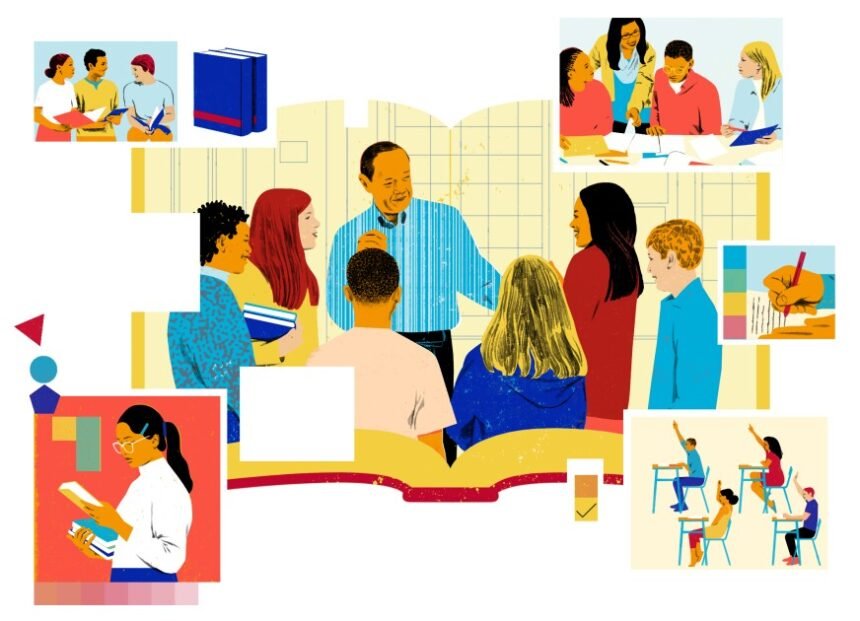Today’s post continues a series in which educators share what they view as the biggest challenges facing teachers—and how to overcome them.
‘Deficit Thinking’
Jason D. DeHart earned his Ph.D. in education from the University of Tennessee, Knoxville. DeHart is currently a high school English teacher and has recently published the book Building Critical Literacy and Empathy with Graphic Novels with NCTE:
I am a literacy-focused person, and so my answer stems from this experience. I think one of the most common problems that I see is that there is so much anxiety and deficit thinking that surrounds what it means to be a reader. I talked with a parent yesterday who was reflecting on how emotional the experience of having a child pulled out for special intensive instruction can be. I also remember being pulled out in 3rd grade for intensive reading intervention.
I think asking some close and complicated questions about what it means to be a reader, how much we should be writing in classrooms (my vote is every day), and why people need to be strong readers in the first place would all be helpful steps. Schools and classrooms should be places where literacy is celebrated. Unfortunately, much of the conversation over the past few years has been focused on how to get books out of students’ hands instead of engaging them in the work of connecting their lives to authentic texts.
Being a strong reader means reading more, and being a strong writer means being engaged in composing in some way on a weekly if not daily basis. Each of my students has a story to share, and I want to help them to unlock that story with all the tools I can provide.

‘Disruptive Behaviors’
Ann Stiltner is a high school special education and reading teacher in Connecticut with more than 20 years of experience in education. She writes the blog from Room A212 . Follow her on Twitter @fromrooma212:
In my opinion, the most common challenges teachers experience in the classroom are student disengagement and the behaviors that can go along with it. Kindergarten teachers all the way up to high school teachers have experienced these difficulties during the last few years, caused by a combination of influences from the prevalence of social media, technology, and the internet to the COVID pandemic.
Some students struggle to maintain attention in busy school environments. Others are unable to share adult attention with other students. Some students lack the necessary skills to deal with peers in an ever-changing social landscape or an understanding of common routines within a school environment.
Struggles with attainment of academic skills due to interruptions in their education during the COVID pandemic lead some students to make use of avoidant and disruptive behaviors to escape challenging assignments. Others lack the ability to tolerate boredom and downtime without being entertained or distracted.
An important antidote to these challenges can be the support and leadership of administrators. However, this creates an added challenge for some teachers when administration lacks the resources, skills, and/or commitment to provide the factors needed to support teachers. This leads to low teacher morale and burnout, which leads some teachers to leave the field and a lack of new teachers entering the field. The situation snowballs as schools lack adequate staff and the remaining teachers need to provide coverage, which leads to more teachers being overworked and in jeopardy of becoming burned out themselves.
I have a few suggestions to offer teachers hope as they attempt to address these challenges.
First, after reading journal articles, attending professional development sessions, and collaborating with colleagues, I have shifted my understanding of student behavior and now see it as a lack of a skill they need, not as a personal failing on their part. Behavior is one of the most powerful ways students communicate with us the skills they are lacking. The American child psychologist Ross W. Greene says:
“The essential function of challenging behavior is to communicate to adults that a kid doesn’t possess the skills to handle certain demands in certain situations.”
Therefore, I see one of my roles as their teacher as helping them learn these missing skills. The skills I teach are not limited to my academic content area but are broader, focusing on the college- and career-readiness skills my high school students will need in the future to function in the world of work and in their community.
Second, I make use of research studies, articles, and social media to stay up-to-date on current issues and developments in education that offer new strategies and approaches to teaching. I read the thoughts and experiences of other teachers to take solace in not being alone and to learn new ways to teach. I then try them out, reflect and repeat if they seem to be working, or tweak them in a way to be more effective for my unique situation.
It is not scientific but involves a commitment and belief that there are ways to be more successful and address student challenges that are respectful of my students and help me feel more in control and competent. Often, I find I need to change things, get out of my own personal rut of how I have always taught, and mix it up. It is not easy but it does make me feel worthwhile when I can see and observe slight shifts in growth and improvements in my classroom environment.
One area of research that has been successful for me in addressing these teaching challenges is trauma-informed instruction. Another area is incorporating hands-on and real-world activities to engage students. I provide choice and build rapport. I listen to what my students communicate to me—whether directly or indirectly, verbally or nonverbally—and respond appropriately.
Finally, I lean on my colleagues. I take comfort in realizing I am not alone but part of a larger community of dedicated professionals who are attempting like me to make a difference.

‘Build Positive Relationships’
Michelle Cummings is the chief academic officer (CAO) at Brisk Teaching. She is the author of The First-Year Teacher’s Survival Guide, 5th Edition published by Jossey-Bass and a consultant for districts, universities, and ed-tech companies:
In workshops across the country, I ask teachers to share their joys and challenges. The most common challenge they identify is disruptive student behavior that derails learning. There is no simple solution, but the best way to meet this challenge is with a three-pronged approach to fostering a healthy learning environment: Build positive relationships, create supportive systems, and facilitate engaging lessons.
Build positive relationships. Invest in establishing relationships with and among students. Learn their names and interests and help them get to know one another.
Take the time to create a community with weekly class meetings and team-building experiences like Traffic Light. In this exercise, teachers place three huge circles in three corners of the room. One is green, meaning, I love it! One is yellow, meaning, I like it. One is red, meaning, I don’t like it. Ask students to move to the corner that represents their opinion on a topic that the teacher calls out. This activity intentionally prompts a variety of groupings so that students get to know one another. Once students arrive in their chosen corners, they turn to a partner and talk about the common opinion they share on the topic. Sample topics may include:
- Pie as the best dessert
- Pineapple as a pizza topping
- Music of the 1980s
Create supportive systems. With relationships as a foundation, teachers create supportive systems, routines, and procedures to support students’ social and emotional growth. Teaching social skills, establishing a calming space in the classroom, building genuine home/school partnerships, and developing and enforcing classroom agreements are among the systems that will improve student behavior. Setting up calming spaces may be the least familiar of these supportive systems, so we’ll explore that strategy in more depth.
A calming space gives students a place to compose themselves when they experience heightened emotions. Such spaces take many shapes, depending on the age of the students and the space available. Some schools have sensory rooms with special equipment to help students regroup. In elementary classrooms, this may be a quiet corner with plants and a cozy beanbag chair.
In secondary classrooms, it might be a corner of the room, the counseling office, a hallway walking loop, a trip to the water fountain, or an exercise bike in the back of the room. Teachers stock the calming space with flashcards featuring various self-regulating strategies to give students some options to choose from, such as breathing exercises and sensory tools such as fidgets, stress balls, or a pinwheel. Younger students like to watch the pinwheel spin, and blowing on it requires them to take deep breaths. It’s vital to explicitly teach students how to use the space and its tools before they become dysregulated.
Facilitate engaging lessons. The third means to reduce disruptive behaviors is designing relevant lessons that incorporate students’ interests and opportunities for student choice. Lessons that ignite curiosity and invite student voice, choice, and agency into the learning process can both inspire learners and reduce disruptive behaviors.
Student-centered choice takes many forms. Some schools create learning contracts for each student in each subject, based on the questions they want to pursue and the real-world problems they want to solve. Others schedule a “genius hour” each week to give students an opportunity to explore their passions. Within the classroom, there are countless ways to offer students choices; one of the most effective is a choice board.
A choice board typically contains nine or more tasks, outlined in a grid, that students can choose from as they work toward learning goals. Teachers distribute the choice board, leaving a blank square for each student to add their own option. The number of assignments students are asked to complete will vary depending on the learning goals, the needs of the student, and the amount of time available.
Sometimes, despite a teacher’s best efforts to build relationships, establish supportive systems, and facilitate engaging lessons, disruptive behaviors persist. So throughout the process, remember to reach out to counselors, social workers, administrators, and the student study team to implement strategies and be prepared to access the next tier of interventions.

Project-Based Learning
Jodi Asbell-Clarke is a senior leader at TERC, an innovative not-for-profit STEM education R&D organization where she focuses on game-based learning, computational thinking, and neurodiversity in K-12 education:
The most common challenges come down to this: Teachers are often overburdened. They are given preparation to do one job, but when they meet the realities of the classroom, much of what is required of them is not what they specialize in or sign up to do as educators. Students come to school with increasingly diverse interests, strengths, and needs, and it is the teacher’s job to help all of them reach their fullest potential.
Education school often teaches potential educators to deliver content, but it doesn’t necessarily focus on the things that mean the most in the classroom. Teachers need to spend much more time building relationships with students and figuring out each student’s unique needs. They must differentiate their curriculum for these diverse needs, which means being insightful and creative in adapting content delivery to the channels most suitable for each student. This takes time, patience, ingenuity, and compassion.
In a traditional classroom, despite a teacher’s desires, intentions, and professional experience, it often seems overwhelming to try to connect with every student. Teachers fear losing control and letting kids slip through the cracks. What I have found in my research, however, is that when students are pursuing their own interests and when they are given some autonomy in the way they learn, even the most challenging students are more engaged and less disruptive. Often, by letting go a bit, a teacher actually makes a stronger connection with their learners.
An effective way to engage student interests is using project-based learning. Project- based learning is a teaching method in which students gain knowledge and skills by working for an extended period of time to investigate and respond to an authentic, engaging, and complex question, problem, or challenge, preferably in their own interest area. The planning and organization that goes into working on a project is where teachers can help students grow and succeed. When students choose their own topics and are free to find their own ways of accomplishing their goals—when they want to solve the problem—they are much easier to teach.
Despite the fact that it seems like the teacher is letting go of control in such a classroom, what I’ve seen is that teachers gain more time to connect with each individual student, and they are able to discover what the student is capable of when given the right situation. They are also able to guide and differentiate the learning process for each student in their classroom. This scenario benefits students and helps make kids feel that their strengths are assets they can build on and that their weaknesses are just areas where they may need more support. And through the context of their own project, the necessary math, language, social studies, and other educational outcomes can often be integrated. In a productive project-based-learning class, learners acquire and retain more information because they care.
It is easier to teach kids when they’re learning in their own way than it is to try to teach every kid to learn in the same way. That’s not to say that it is all on the teacher. Educational designers need to provide teachers with flexible and adaptable materials so they can differentiate instruction for all learners in their class, and administrators can promote these more inclusive teaching approaches by allowing time for co-teaching and fostering collaboration among teachers

Thanks to Jason, Ann, Michelle, and Jodi for contributing their thoughts!
Today’s post answered this question:
In your experience, what are the most common challenges teachers experience in the classroom, and what do you think are the best solutions to them?
In Part One, Penny Kittle, Chandra Shaw, and Patriann Smith contributed their responses.
In Part Two, Michael D. Steele, Joleigh Honey, Serena Pariser, Malkia Williams, and Stephen Katzel wrote their answers.
Consider contributing a question to be answered in a future post. You can send one to me at lferlazzo@epe.org. When you send it in, let me know if I can use your real name if it’s selected or if you’d prefer remaining anonymous and have a pseudonym in mind.
You can also contact me on Twitter at @Larryferlazzo or on Bluesky at @larryferlazzo.bsky.social .
Just a reminder; you can subscribe and receive updates from this blog via email. And if you missed any of the highlights from the first 13 years of this blog, you can see a categorized list here.







